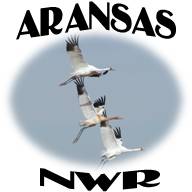Archive for May 28, 2009
Aransas Whooper Update
May 28, 2009Tom Stehn, Whooping Crane Coordinator reports that, “ Four whooping cranes were seen by experienced staff this afternoon (May 28, 09) at Aransas NWR along the Intracoastal Canal that runs through the Aransas National Wildlife Refuge. The cranes were grouped as a duo, and then about 5 miles away were two singles separated by 100+ yards. I presume all 4 are subadults.”
Tom adds that, “I have not done a census flight since April 21st , and probably will not do so until July to see if these 4 decide to spend the summer and whether any others are still around. These 4 cranes could still migrate, but they also could spend the summer at Aransas.”
Florida Non-Migratory Whooping Crane Update #5:
May 19, 2009Marty Folk, Florida Fish and Wildlife Conservation Commission reports that, “The two active whooping crane nests described in my 5th Update have failed. One nest failed on Saturday and one Sunday. Visits to the abandoned nests revealed no eggs or remains. Water levels had declined such that it would have been possible for mammalian predators to approach the nests without getting their feet wet. Normally the birds abandon at this point so the nest failures were predictable. The Polk County nest was in a large lake that was not immune to the drying effects of this drought. We still could see a nesting (our latest laying date is 27 May) but not likely from the 2 pairs that just failed. The chick in Osceola County is now 60 days old.”
Marty explained that, “The South Florida Water Management District recently reported that the
period from November 2008 through April 2009 ranked as the driest
six-month period in South Florida history based on records dating back
to 1932. The trouble is, we began this drought back in 2006 and had
already accumulated a large deficit prior to November last year.
However, this week a stalled front is bringing rain to Florida! We’ve
had 3.2 inches of rain at my house this week (it seems like the Great
Flood), and some areas have gotten more. It is “too little too late” for
this breeding season, but is a start for rehydrating the thirsty
landscape.”
Newsletter – Spring 2009
May 15, 2009Florida's Non-Migratory Whooping Crane Flock – 2009 Update #4:
May 5, 2009Great news!
Marty Folk,Florida Fish and Wildlife Conservation Commission issued his second update report for the day (5-5 09). Marty notified us that, “The minute I sent out my update #3 on Florida’s non-migratory flock of whooping cranes (see below) we discovered another nesting (actually a re-nest). The pair who had the 2nd nest (in Lake County, see report below), have re-nested and currently have 1 egg, just laid since yesterday’s check of the pair. We moved our video surveillance equipment and began recording their behavior.”
WCCA is thrilled to send you Marty Folk’s” report. Hopefully, this nest will be another success. We will keep you posted.
Florida's Non-Migratory Flock – 2009 Update #3:
May 5, 2009Marty Folk, Florida Fish and Wildlife Conservation Commission biologist reports that: “Earlier I reported on a whooping crane chick in ‘nest #1’.The chick from nest #1 still survives and is 46 days of age today (May 5, 2009). The eggs that we collected from ‘nest #2′ showed no sign of embryos. The pair at nest #2 produced fertile eggs during their previous 3 nest attempts and we suspect that winter rainfall was insufficient to stimulate copulation or some aspect of egg or sperm production. We now have a new nest by a pair in Polk County. They are nesting in a lake because all marshes in the area are dry.”
Marty advised,”We continue intensive daily monitoring in order to document survival and movements of the whooping cranes. Also, as you may know, we have identified that male whooping cranes aren’t living as long as females, and that male whooping cranes are more vulnerable to collisions with power lines than females. We suspect this may be associated with the males’ propensity to lead the flocks and be the defenders of the flocks. We are also collecting behavioral data to help us learn more about this. We also continue to gather data on whooping crane feather molt. Every other year, on average, adult whoopers molt all their flight feathers and are grounded for an average of 44 days while the new feathers grow.”
Marty stated that in the area of Florida’s non-migratory whooping crane habitat there is no sign of relief here from the drought. The long days with high temperatures at 90 degrees really bake the landscape.
Summary of Nesting in the Three Whooping Crane Flocks
May 5, 2009Brian Johns, Wildlife Biologist, Canadian Wildlife Service sends a brief report on the most recent events concerning the Aransas-Wood Buffalo whooping crane flock, the Wisconsin-Florida migratory experimental flock and the Florida non-migratory experimental flock.
Aransas/Wood Buffalo flock:
Brian reports that, “Some whoopers that departed their Aransas, Texas wintering habitat have migrated to Canada while others continue on their way. The cranes are in the process of completing their migration to Wood Buffalo. There have been fewer sightings in Canada this spring compared to other years, which may mean that the birds have had good migration conditions and have moved on through or that there are still a few birds to come. Habitat conditions on the breeding grounds appear to be near normal and Lea Craig-Moore will begin nesting surveys in about 10 days.”
Wisconsin/Florida:
Brian advised that, “Twelve nests were initiated this spring in Wisconsin and as of May 3 all nests had failed.”
Florida:
Biologist Johns wrote that, “Three nests were initiated by whoopers in Florida’s non-migratory flock. One nest failed, one is being incubated and one has a 46 day old chick.”

